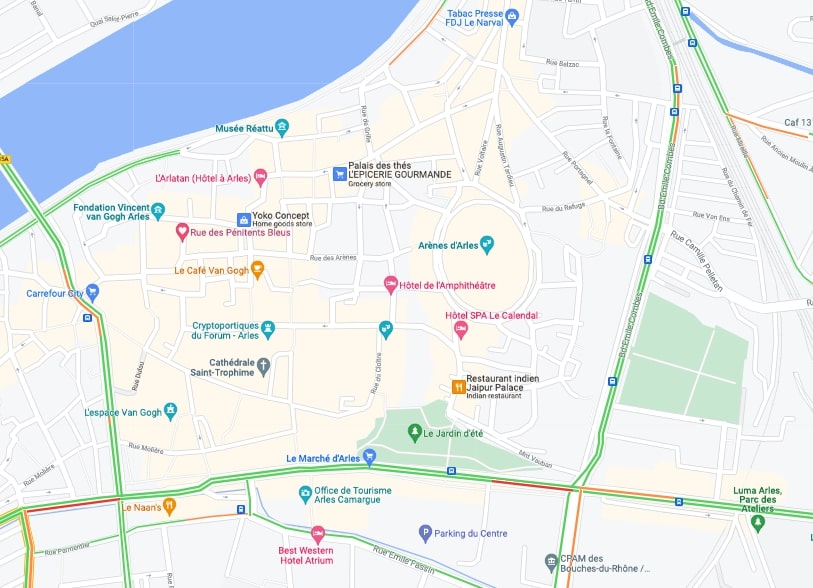Unsure about your French table manners? Click Here to download > > How to avoid these 10 food etiquette mistakes !
- Home ›
- Culture & Civilization ›
- Roman France ›
- Arles
The Arles Amphitheater: Top 10 Magnificent Roman Monuments of Arles
Published 19 April 2022 by Leyla Alyanak — Parisian by birth, Lyonnaise by adoption, historian by passion
The first time I visited Arles was for the Rencontres de la Photo, an international photography festival. This time, for a week in winter, I had only one thing on my mind: Roman ruins.
Medieval streets may have grafted themselves onto Roman roads and new, modern architecture has found its place in the city, but Arles was and remains a quintessentially Roman city, with some of the best Roman ruins in France.
Wherever you go in Arles, Rome will stare back at you, a column here, and a stone there, reminding you of who built this city.
There's the Arles Amphitheater, of course, the biggest, best, most famous remnant of Rome's power and the most popular of the Arles attractions. But you'll catch your breath at others, too, so remarkable most are on Unesco's World Heritage List.
NOTE: Pages on this site may contain affiliate links, which support this site. See full Privacy Policy here.
Let's explore the Roman heritage of Arles, lifting us back to a time when Caesar conquered Gaul.
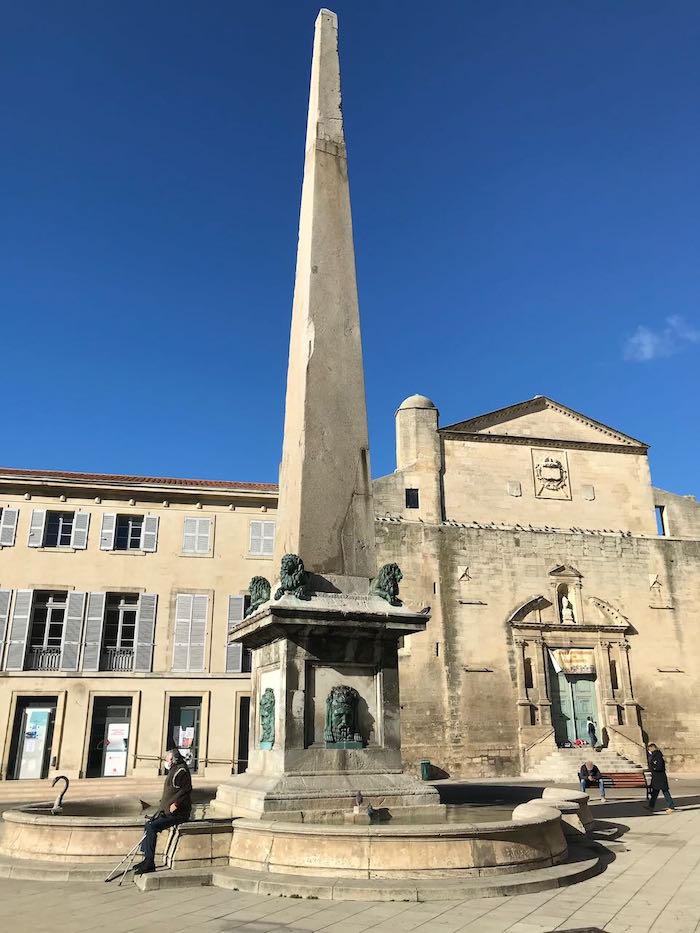 The Roman obelisk as it stands today on the town's main square
The Roman obelisk as it stands today on the town's main squareThere are several ways to explore the Roman Arles monuments.
You can wander, map in hand. Arles is absolutely walkable.
You can enjoy a private guided tour, especially if you're a fan of history and would like someone to explain all this wonder.
Or you can visit the Musée de l'Arles Antique for a dazzling overview of the Roman period, and of two pieces that on their own are worth the visit, but more on that below.
The Cryptoporticus
It's a little difficult to guess the exact dates of the various Arles Roman ruins, but the city, while occupied for 2500 years, officially became a Roman colony in 46 BCE, so we can safely assume building of the major Arles monuments only began after that date – and this seems to mesh with the history that we know.
As in any Roman city, the first public building would have been the Forum, the central place of government, where people met, and where the market was usually held.
And so it would be in Arelate, "the city near the marshes", as Arles was then known, about to embark on a Rome-funded building spree to thank the city for siding with Caesar against Pompey during the recent civil wars.
But building the Forum required foundations, or cryptoporticoes, because the forum was to be built at the crossroads of the two main roads into the city, and it happened to be on an incline. The semi-subterranean horseshoe-shaped set of archways were meant to stabilize the structure.
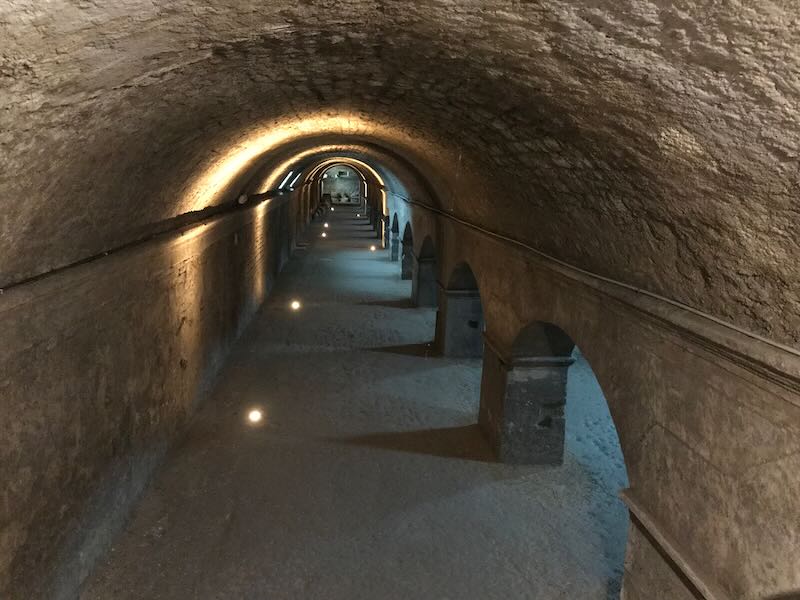
At the time, the tunnels were ventilated and lit by openings at the top of the walls but these have been covered and replaced by electric lights.
Hundreds of years later, as the Roman Empire began its slide into darkness, the cryptoporticoes were split up and used as private cellars, perhaps rented out to bring in income (my guess and in no way based on fact).
They may have been used for a variety of purposes: as granaries, holding cells for slaves, a prison, or even catacombs. They were forgotten as a church was built on top... and rediscovered bit by bit when the City Hall building was erected in the 17th century.
The site would finally be cleared in 1951 and eventually opened to the public, and is one of several Arles Unesco sites.
As for the forum that stood above it, little is left... but here's what the town would have looked like then.
CURIOUS ABOUT ROMAN LIFE?
If you're keen to find out how Gaul not only allowed the Romans to march in but welcomed them, Becoming Roman, a product of Cambridge University Press, will enthral your inner archaeologist and anthropologist.
Buy from Amazon or from your Independent Bookstore
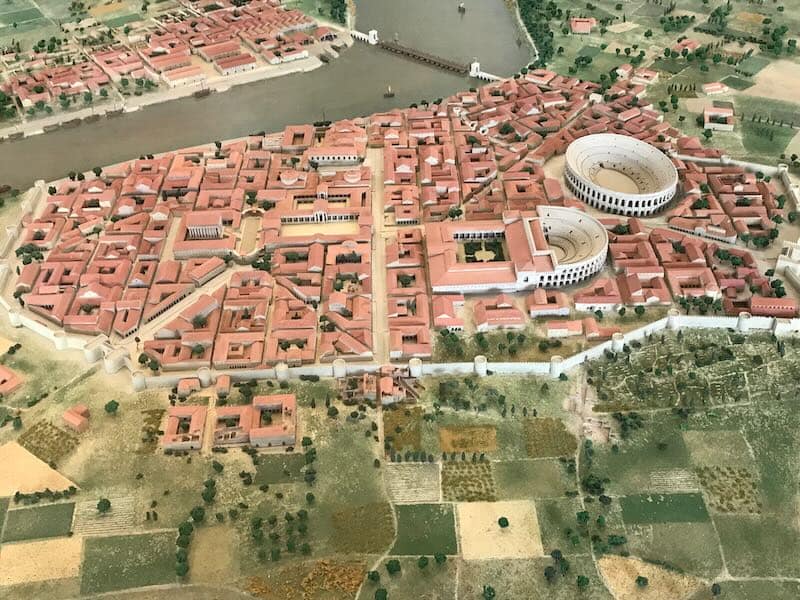 Here's what the town would have looked like in its heyday, a scale model you can see at the Arles Museum of Antiquities. The forum would be the small but tall-ish building on the left, supported by a row of tight columns
Here's what the town would have looked like in its heyday, a scale model you can see at the Arles Museum of Antiquities. The forum would be the small but tall-ish building on the left, supported by a row of tight columnsPlace du Forum
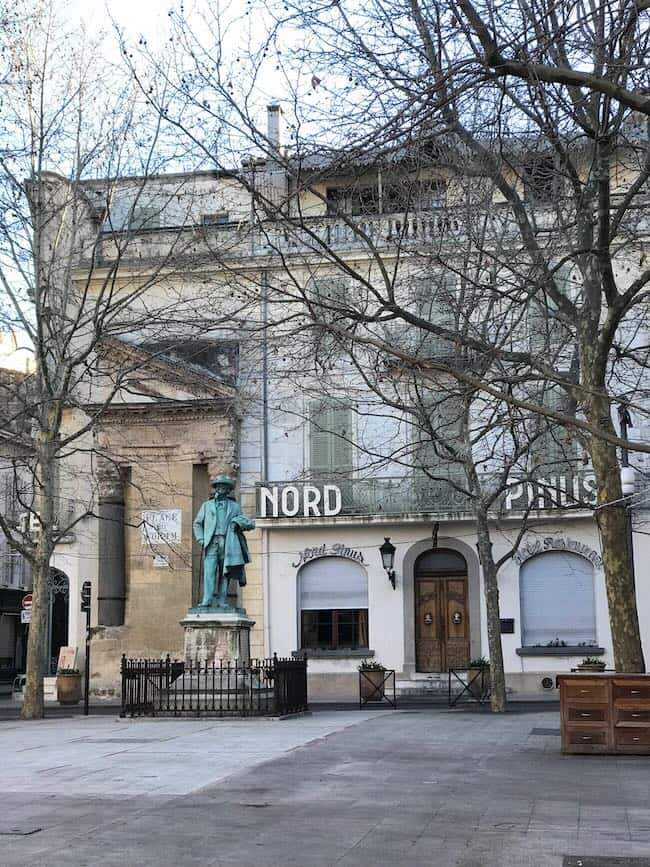 Behind the statue of Frederic Mistral, the renowned Provençal writer, to the left, stand the two remaining columns of the Roman Forum which once stood on this square
Behind the statue of Frederic Mistral, the renowned Provençal writer, to the left, stand the two remaining columns of the Roman Forum which once stood on this squareYou'll have to use a lot of imagination because you won't see much that is Roman on this square, other than the name.
But there IS something.
The actual Roman Forum was a bit to the south, but a Roman temple did once stand here. The two columns which now guard the corner of the Nord-Pinus Hotel, behind the statue of poet Frédéric Mistral, may be remnants of that temple, although some say they were part of the Forum.
We may never know exactly where they came from, but they ARE Roman.
The Roman Theater of Arles
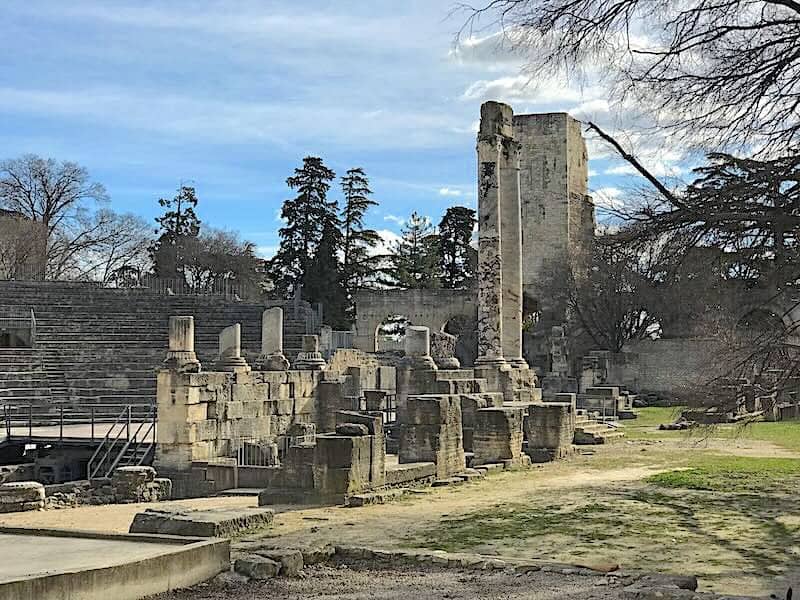 What's left of the Arles Antique Theater. The two columns are known locally as the "two widows". To the left you can see the seating of the theater.
What's left of the Arles Antique Theater. The two columns are known locally as the "two widows". To the left you can see the seating of the theater.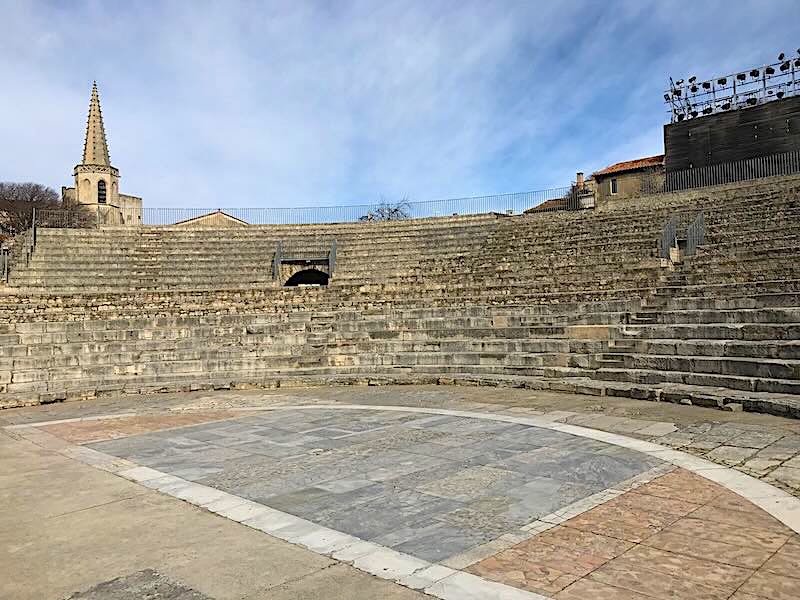 The seating area of the theater
The seating area of the theaterThe next major Roman building to emerge in Arles was the Théâtre Antique, or the Arles Roman theater, where you (and 10,000 other spectators) would come at sunset to watch tragedies and comedies in what was one of the Roman Empire's first stone theaters.
It suffered the same ignominious fate as many remnants of Antiquity – locals simply walked away with the stones and used them to build their houses. All that was left at excavation were foundations, a few scattered columns, and the semi-circular seating in front of the stage.
While it may not compare with the amphitheaters of Orange or even Lyon, the columns and remaining seating spaces are harmonious and spending some time on those stone seats may take you back to those early plays, if even for a moment.
Like many other Roman Arles monuments, it has come full circle, used again today for performances, as it was in Antiquity.
➽LOOKING FOR AN ARLES HOTEL?
I stayed in this PERFECT APARTMENT in the Old Town!
The Arles Amphitheater
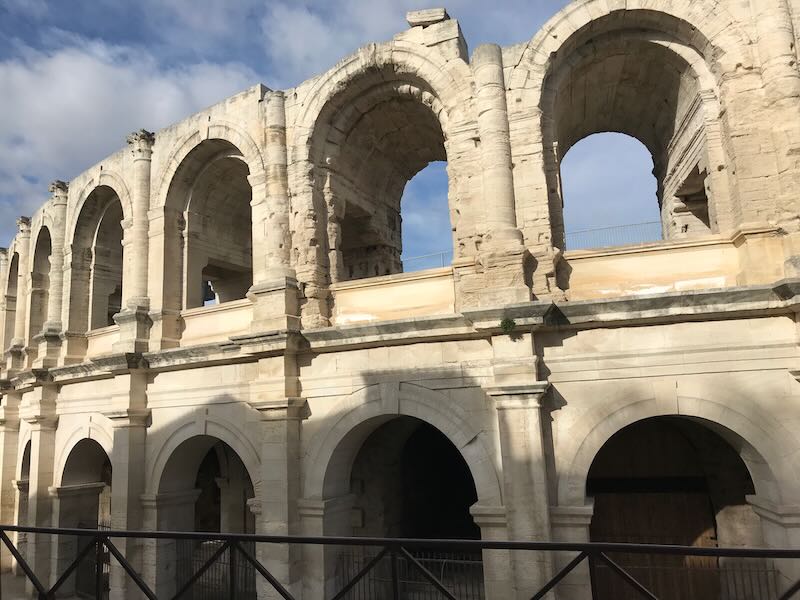
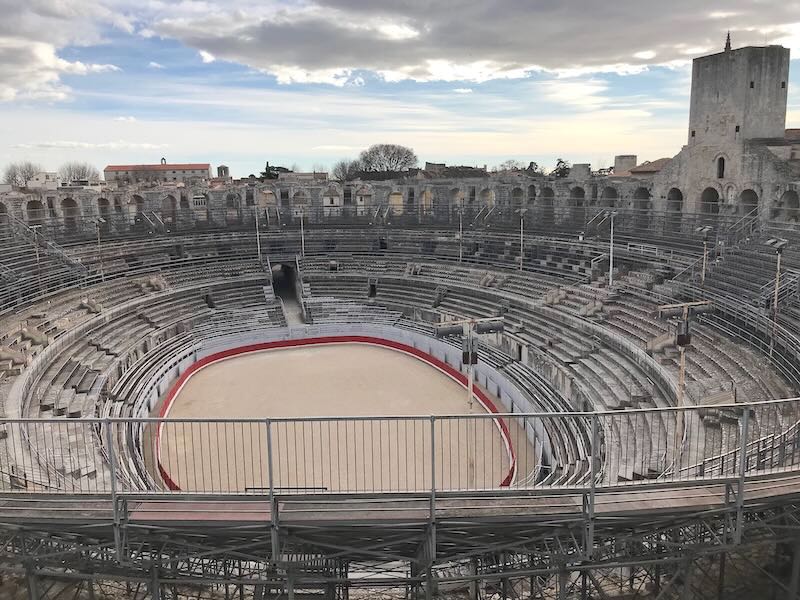 The Roman amphitheater of Arles seen from the outside and inside
The Roman amphitheater of Arles seen from the outside and insideNot too far from the theater (nothing is more than 10 minutes away on foot in Arles) is the Amphitheater, or Arles roman arena, a national historical monument built a few years later, in 90 CE.
It's such a striking building you may have already seen pictures of it: two tiers, 120 arches, and nearly 2000 years of history.
Between chariot races and gladiator fights, this is where you came for your dose of bloody sports. With seating for 20,000 spectators, one has to think these sports were popular.
Like all the outlying Roman arenas across France, the one in Arles was inspired by Rome's Colosseum, albeit a little more modest (because nothing can be allowed to outshine Rome), a simple oval arena surrounded by dwellings today.
Its later history is even more fascinating. As has been the case for many buildings in France, the Arles arena filled its empty center with housing, mostly for defence purposes. When the barbarians attacked, all people had to do was move into the heart of the Amphitheater for protection.
And move in they did, until more than 200 houses and two chapels filled the area where man and beast had once fought to the death.
In fact, this defensive mandate may well have saved the Amphitheater from destruction. People built their homes with its stones, so yes, it was damaged, but by living there, they guaranteed the entire structure wouldn't be torn down.
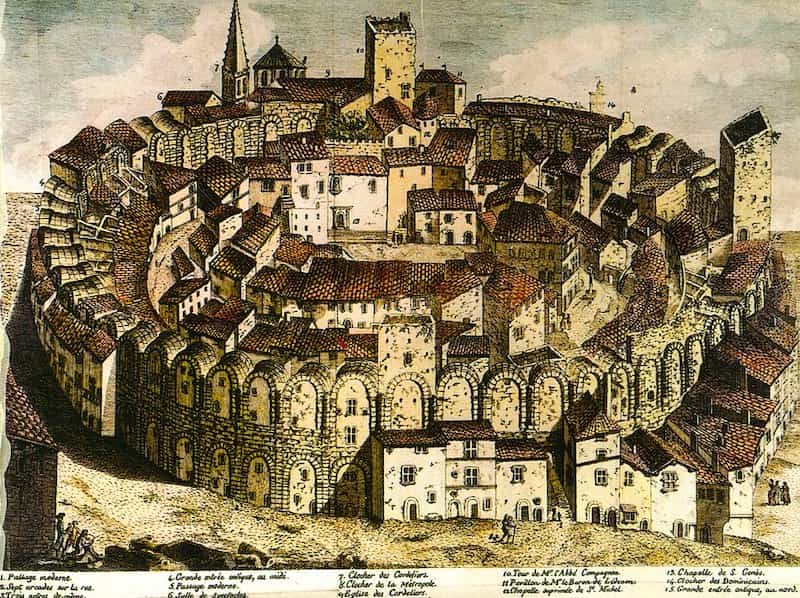 This old engraving by J.B. Guibert (scanned by Robert Schediwy) gives you an idea of what the Amphitheater was like as a village and defensive fortress
This old engraving by J.B. Guibert (scanned by Robert Schediwy) gives you an idea of what the Amphitheater was like as a village and defensive fortressDuring the Middle Ages, four towers were added (three remain) and climbing up the main tower provides an unparalleled view over Arles.
Today the Arena (the name is interchangeable with Amphitheater) holds concerts and performances and is a prominent tourist attraction in Arles.
Its original purpose, man fighting animal, has also come full circle. As they did in Roman times, men fight animals here.
You'll find two kinds of bullfights in Arles, especially during its two annual ferias (Easter and autumn festivals): the traditional Spanish-style corrida, in which the bull is poked with spears and eventually killed (as is, occasionally, the bullfighter), and the Course Camarguaise, in which no bulls are killed.
The Roman Circus
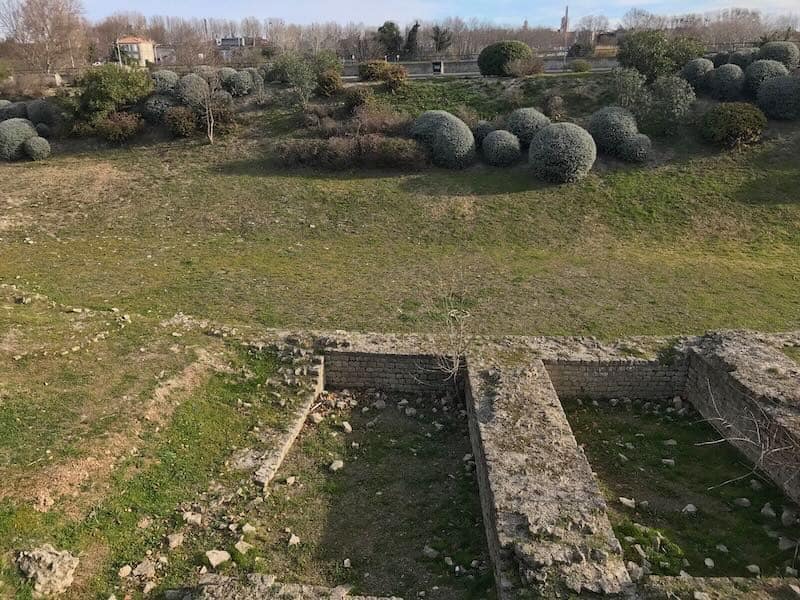 What is left of the foundations of the Roman Circus of Arles
What is left of the foundations of the Roman Circus of ArlesThe Circus would have been the largest Roman venue in Arles, nearly half a kilometer long (more than 500 yards), its sides filled with 20,000 cheering spectators egging on the chariots and horse racers.
It was built just outside the city limits, on land partially occupied by the Arles antiquities museum. But it wasn't an easy build: the area is marshy, and 30,000 wood pylons would have to be pummelled into the ground to stabilize it, no mean feat without mechanization.
Eventually, as Christianity spread, authorities recoiled at this type of pagan entertainment and with the arrival of plague in the 6th century, people retreated to the town and the Circus was abandoned.
Today, you can see what's left of the foundations right outside the museum but you'll get a better sense of its spread if you walk to the museum from downtown (rather than taking the €1 electric bus – save that for the return journey). The sidewalk unfurls along a decent length of the former Circus... but the majority of the foundations are now covered by a section of motorway and a new neighbourhood.
Pieces of the Circus, like some of its wooden pylons, are preserved inside the museum but perhaps the most spectacular remnant is the obelisk that stands on the Place de la République outside City Hall.
If you like your history with humor and pictures, please treat yourself to France's iconic comic-book series, Asterix and Obelix. The two fearless Gallic warriors take on the invading Romans, inevitably winning each battle, often due to a magic potion prepared by their beloved druid. It's intelligent, funny, and very very French. Buy from Amazon or from your Independent Bookshop
The Obelisk
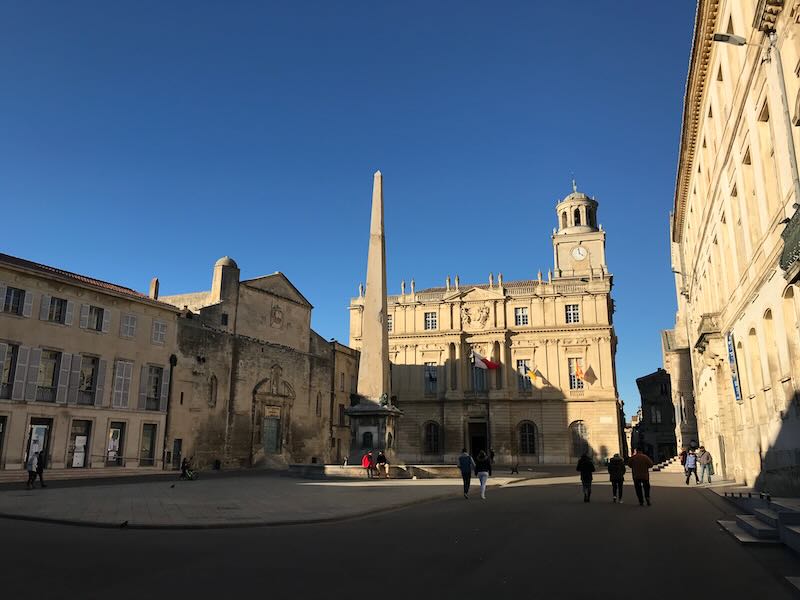 The Obelisk now stands at the center of the Place de la République. Right behind is City Hall, whose foyer houses the entrance to the Cryptoporticus
The Obelisk now stands at the center of the Place de la République. Right behind is City Hall, whose foyer houses the entrance to the CryptoporticusThis proud Obelisk once stood in the spina of the Circus, the central spine around which racers turned their horses and chariots at the halfway point.
As the Circus was abandoned, the Obelisk broke (or was broken) in two. The base was left in the Circus, but the tip somehow ended up as a bench in central Arles.
The base was rediscovered in the 14th century and, like a precious work of art, was shown off to dignitaries as they passed through Arles.
The two pieces were eventually reunited but no one quite knew what to do with the 15-meter needle until, under Louis XIV, the city's notables decided to erect it on the Place de la République (which was then, of course, called the Place Royale) and built a stone base to welcome it.
And there it stands, relatively unchanged.
I say relatively because its tip was once graced by a bronze globe and a sun. During the Revolution, the sun was replaced by a Revolutionary bonnet and with the arrival of Napoleon, an eagle. Then, when the monarchy returned during the Restoration, a rooster replaced the eagle and, finally, the sun made its way back.
Enough already! In 1866 the city did away with the various coifs and replaced them once and for all with a discreet bronze pyramid.
Other than the few foundations, the Obelisk is all that remains of the Roman Circus.
Today, a few scattered benches line the square, used in winter by the city's elderly to catch the first rays of the sun, and by young people as a gathering place.
Baths of Constantine
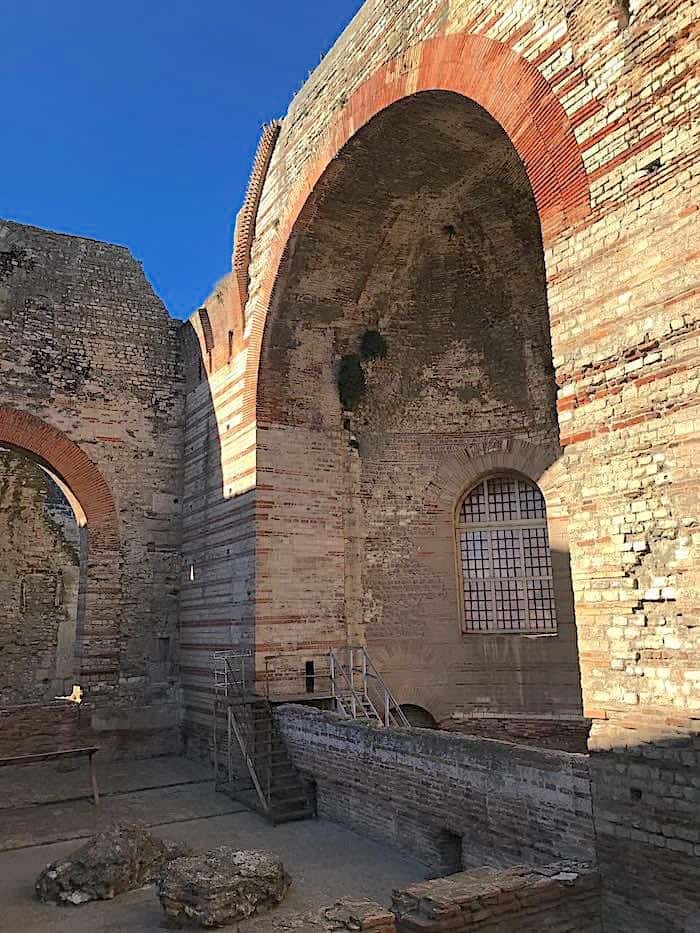 Constantine's baths
Constantine's bathsEmperor Constantine I, or Constantine the Great, was a busy man.
He inherited the job from his father, and further consolidated the Roman Empire through war. He introduced coins as currency, reorganized the army, resettled bordelands, and – most famously – was the first Roman emperor to become a Christian.
Among his many building projects was an Imperial Palace, of which these baths, only part of which have been cleared, are the only remains.
You won't find any larger or more spectacular baths with style in Provence.
As an interesting aside, the best Arles hammam (steam bath associated with Mediterranean regions) is located right around the corner from Constantine's baths. Although in no way ancient, it's not hard to sit in the steam room here and imagine being surrounded by the baths, just a few meters away.
The Alyscamps
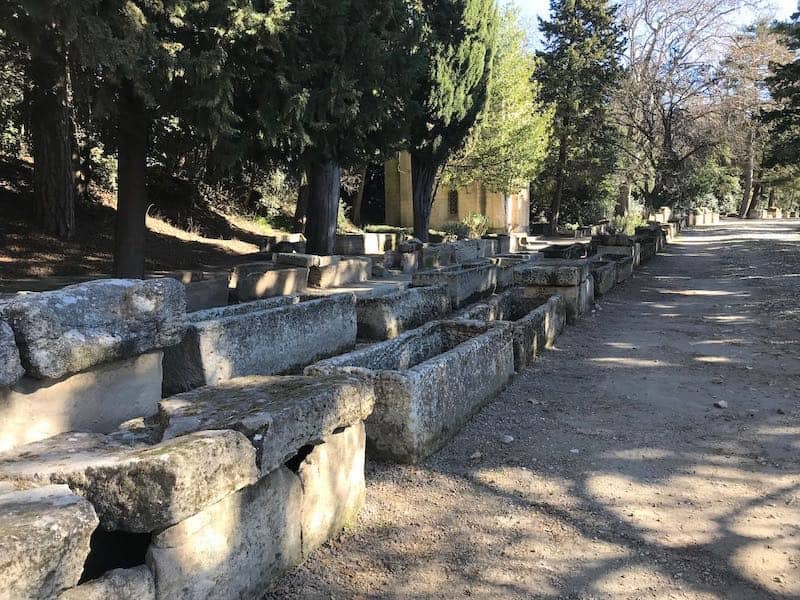
Rarely has a more beautiful setting been found for a necropolis.
If you were alive in Antiquity and walked into town along the Via Aurelia, you'd walk right past the Alyscamps, and you would be greeted by much the same sight as greets you today: a long line of cypresses and plane trees, with a row of sarcophagi.
The name Alyscamps, by the way, means Elysian Fields – yes, the Champs Elysées!
In Roman times, people were buried along a city's periphery and back then, the Alyscamps was out of town. Now, it's a ten-minute walk from the center.
A sarcophagus, by the way, is a place of burial, a tomb of sorts, or a mausoleum, often made of stone and engraved with signs and words that identify its occupants.
When someone died and the family wanted them buried here, they placed the body on one of the boats that plied the Rhône and floated it downstream with coins in their mouth or hands. Gravediggers would retrieve the bodies at the Trinquetaille Bridge and bury them, pocketing the fee.
At the end of the Alyscamps alley is a 12th-century church that belonged to those who guarded the necropolis. Poorly lit and cavernous, you can discern some wall paintings but on the day I visited, I was alone and not even a flashlight would get me to descend into the subterranean chapel.
As is the case with most ruins, the sarcophagi (or sarcophaguses, both are correct) frittered over time, offered as gifts to notables or used as stones for building. Some were removed and destroyed during the building of a nearby railway (the railway company should have known better).
It's not the kind of thing you would normally say about a necropolis, but the setting is enchanting, so much so that Van Gogh painted it while he lived in Arles.
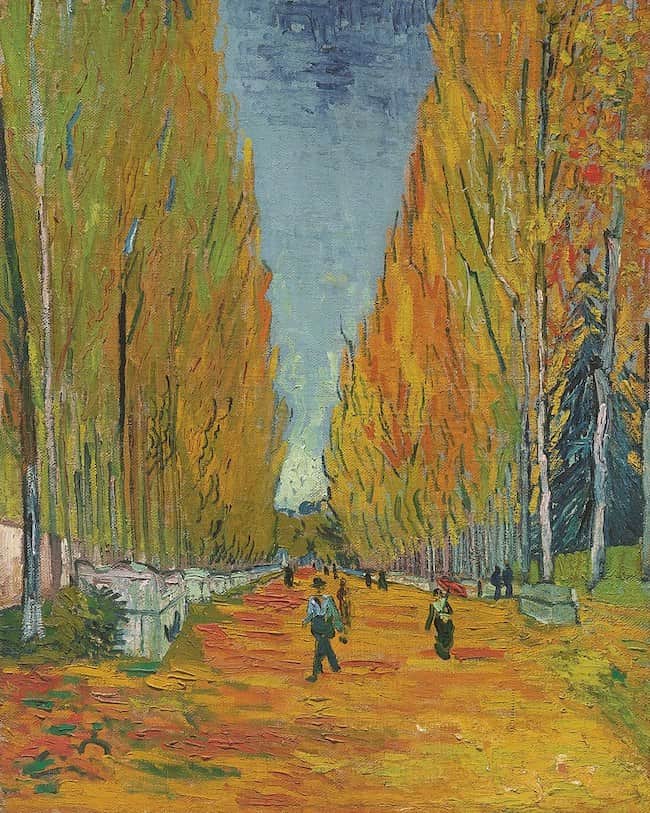 This is one of the two Alyscamps paintings Van Gogh created in 1888, while he lived in Arles
This is one of the two Alyscamps paintings Van Gogh created in 1888, while he lived in ArlesREAD MORE: France's Abandoned Places
Roman ramparts of Arles
Every good Roman city has its walls and Arles is no exception.
The ramparts were among the first Arles monuments to be built in the new Roman colony but little is left of them.
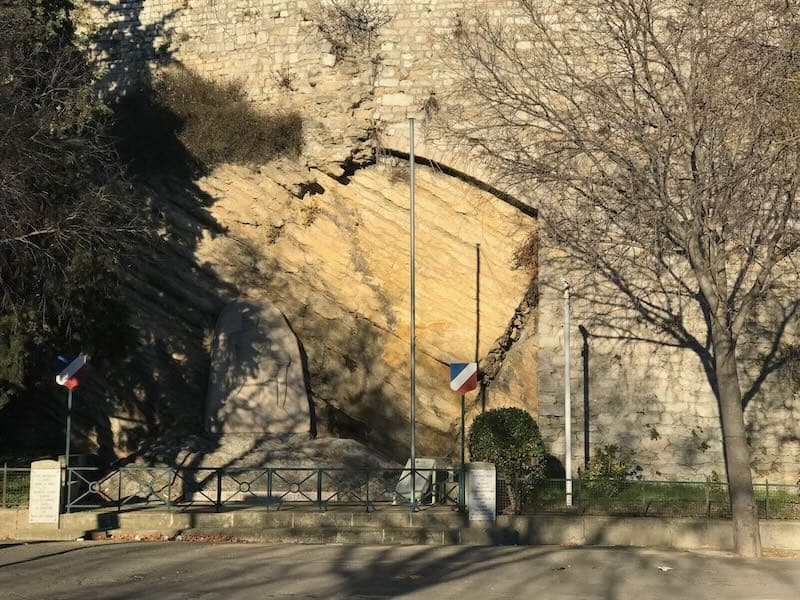 The monument to the war dead with the ramparts as backdrop
The monument to the war dead with the ramparts as backdrop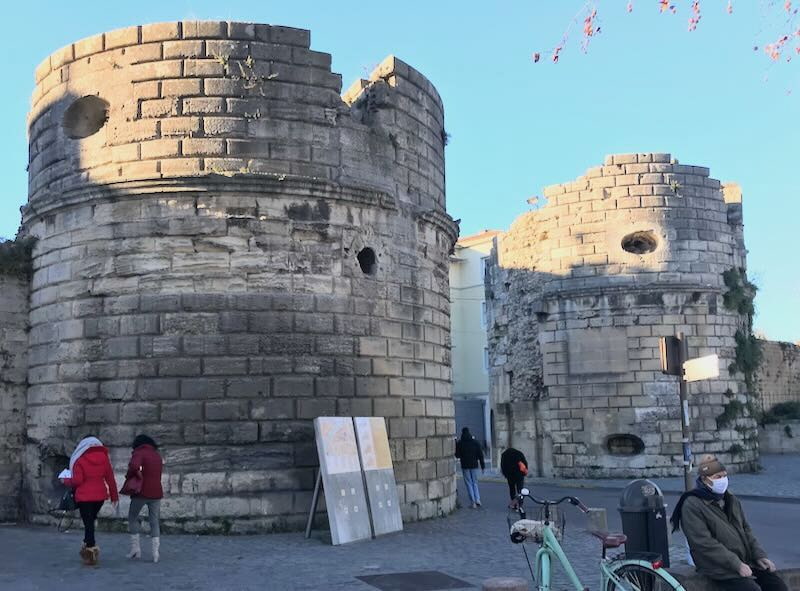 Today the ramparts serve as a backdrop to the weekly Arles market
Today the ramparts serve as a backdrop to the weekly Arles marketInitially built under Emperor Augustus during the first century BCE, they guarded the entrance to Arles from the Via Aurelia. Much of the ramparts were dismantled to build the Amphitheater or to open up new neighbourhoods.
Eventually, as dangers to the Roman Empire multiplied, the ramparts were reinforced and Arles would be the last Gallic city to fall to the Wisigoths in 476. The ramparts would be rebuilt, but not for nearly 100 years, when they would encircle the entire city.
These days you can see a few of the remaining towers, and the wall leading down the boulevard Emile Combes. On Wednesday mornings, a massive food market takes place at the foot of the ramparts.
Caesar's bust
Earlier, I mentioned the Museum of Antiquities, while extraordinary, has two pieces that on their own merit a visit.
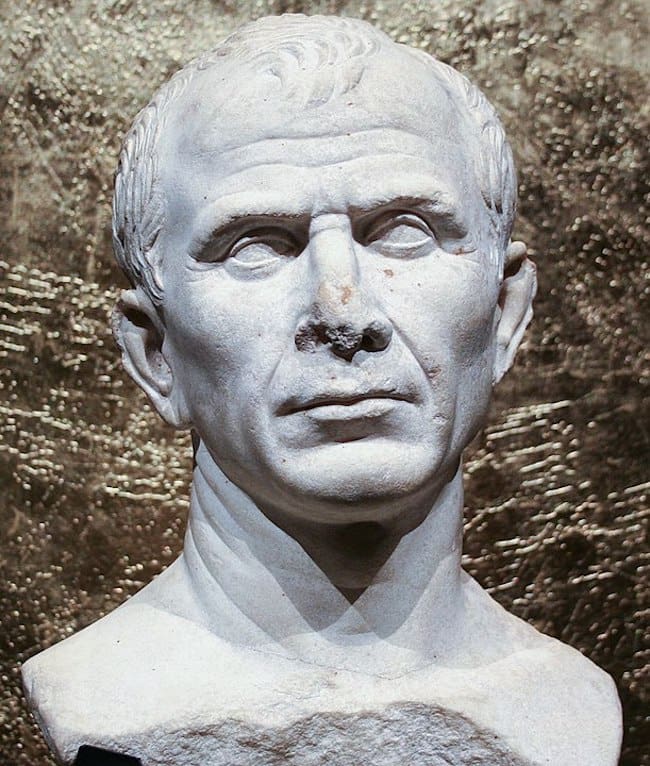 The purported bust of Caesar. Photo by Mcleclat IRPA, Musée Arles Antique, CC BY-SA 3.0 via Wikimedia Commons
The purported bust of Caesar. Photo by Mcleclat IRPA, Musée Arles Antique, CC BY-SA 3.0 via Wikimedia CommonsOne of them is known as the Caesar Bust, was found in 2007 by divers under the waters of the Rhône River.
Archaeologists date it back to 46 BCE and it is believed to be the oldest known likeness of Julius Caesar. Some experts suggested the bust had been thrown into the river after his assassination, when owning a replica of Caesar might have not been politically wise.
It probably doesn't really matter WHAT Julius Caesar looked like. Of far greater interest is how he lived, and how others lived during his era. Buy on AMAZON or from your Independent Bookshop.
The experts are not in agreement, however, and others say the bust bears no likeness to the face on coins minted during Caesar's reign.
We may never know the truth...
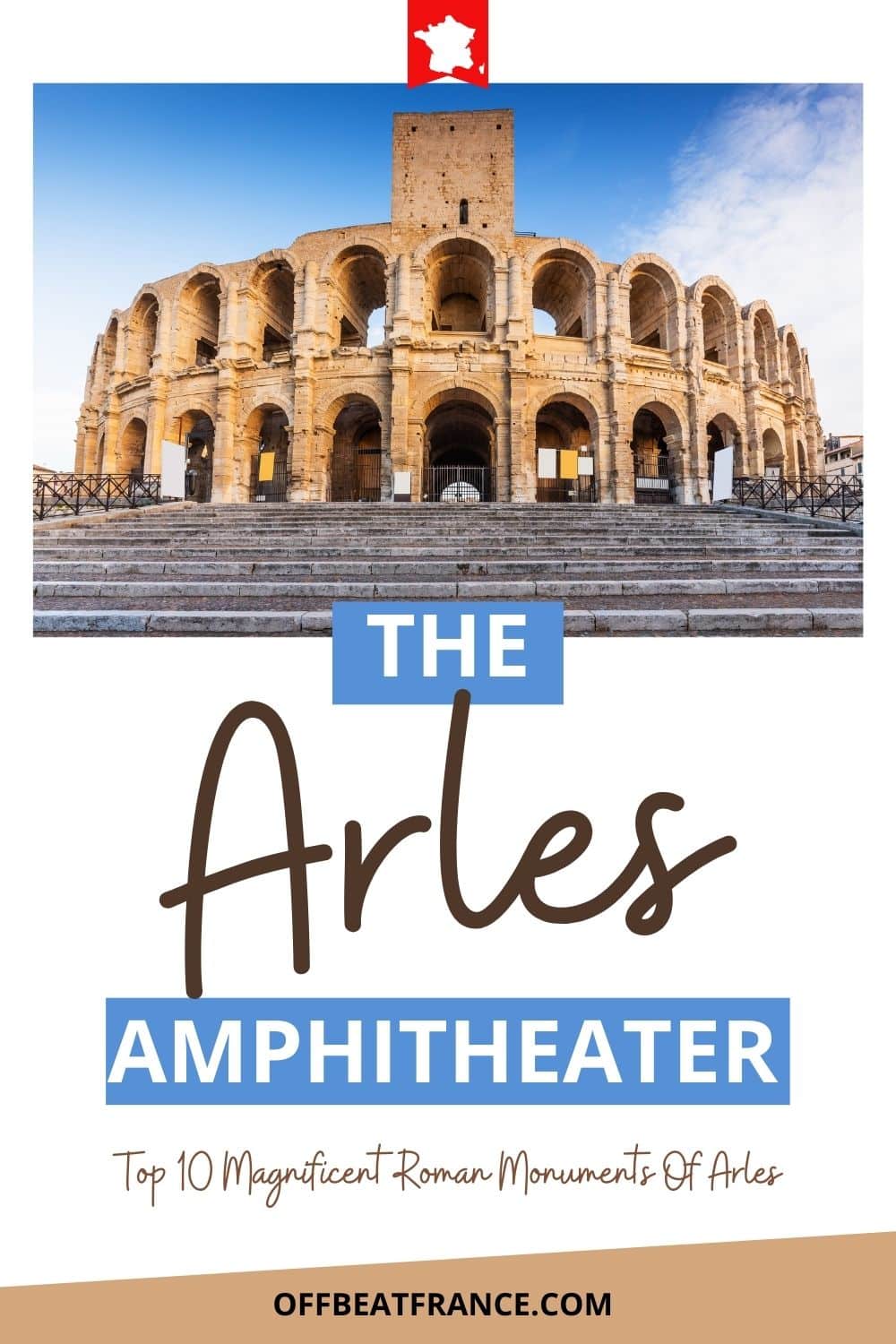
The flatbed boat
The other piece of great significance is this flatbed barge, known as a chaland, probably built in Arles sometime during the first century CE. This was a transport barge, ferrying merchandise along the Lower Rhône.
When it was found underwater, it still had its cargo of stones, its coins, and its moorings. Rarely has such a glimpse into Roman river life been available.
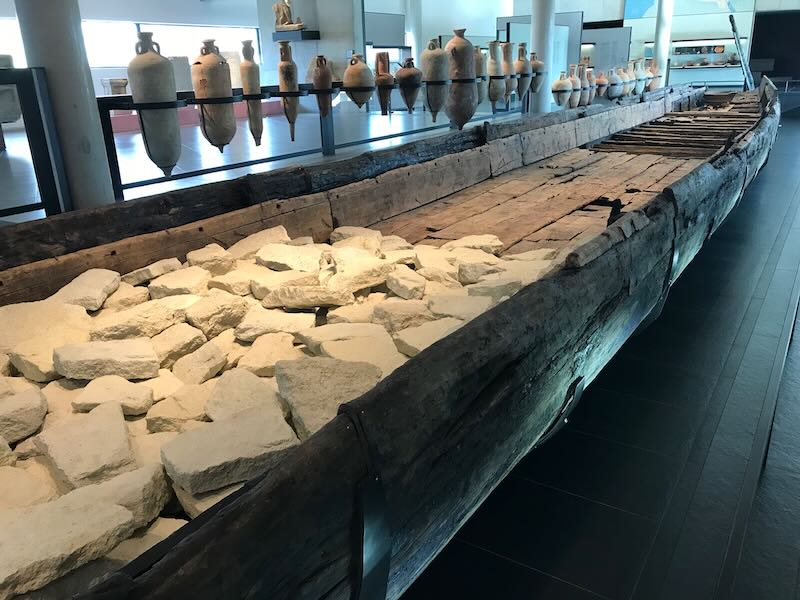
We often don't realize the importance of river traffic to Rome. We know the roads, but the rivers were equally crucial, especially to commerce, allowing goods from the sea to sail upwards into the center of Gaul, and from there, along other river networks right to the edge of the empire.
The barge was discovered in 2004, when a diving team came upon a cache of Roman amphorae, with part of the barge visible. It turned out to be one of the best-preserved barge specimens from Roman times.
A project, Arles-Rhône 3, set out to raise and restore the barge and painstakingly restore it: the results are spectacular.
Along with the barge are some 450 objects related to this fluvial trade, but plenty more remain underwater, waiting for the time and money to raise them.
NOTE: Make sure to buy a pass from the Tourist Office that allows free entry into most of the Arles monuments. It's absolutely worth it!
Arles France map
A bit of Arles history
Arles had a few outstanding periods in its history.
By the 6th century BCE, it had already been colonized by the Greeks, along with nearby Massilia (Marseille).
Now you may remember that Caesar was on the rampage in Gaul in his bid to "pacify" the locals and in 49 BCE, he captured Marseille, propelling Arles into prosperity as a major port, both for seagoing vessels (it was closer to the sea in those days) and for river traffic.
Caesar and Pompey had a few skirmishes and as I mentioned earlier, Arles sided with Caesar by building warships for his fight against Pompey. The city was rewarded for its loyalty with status and with the settlement of the veterans of Caesar's 6th Roman Legion here.
And the building began.
First came the forum, between 30-20 BCE, with foundations that survive to this day, and the other magnificent buildings followed.
A particularly phenomenal piece, the Venus of Arles, was discovered in the Theater during the 17th century and offered to Louis XIV as a gift for his Versailles palace. But as was the case for many works of art, the Revolution carted it away from Versailles but it has thankfully found a home in the Louvre.
Arles eventually became the capital of the province of Gallia Narbonensis, Rome's first province beyond the Alps, and with this prosperity came the elaboration of the vast necropoles, filled with exquisitely carved sarcophagi, of which the Alyscamps is the last vestige.
The 4th and 5th centuries of the early Christian era were Arles' heyday. It raised sheep. It manufactured metals, cloth and weapons. It minted coins. It exported wheat and olive oil and wine, and became so powerful it eventually became the province's capital.
With the rise of Christianity, pagan blood sports were gradually shunned, and many of the Arles Antique Roman buildings which had served up that kind of entertainment were abandoned. Its importance as a religious center grew, while its political role faded.
Yet building continued throughout, from medieval churches and cloisters like that of Saint-Trophime (a Unesco World Heritage Site) to Renaissance buildings and manors which still stand, ensconced in corners of the city.
Over the years the city's fortunes would rise and fall, somewhat eclipsed economically by Marseille and politically by Aix-en-Provence, but the real blow came when it was bypassed by the new railway line.
As it has done so many times in the past, the city orchestrated its rebirth from the second half of the 20th century, becoming a cultural beacon that would host publishing houses, the renowned Arles photography festival, and the most recent arrival, the Luma Foundation cultural center, with its stainless steel tower designed by Frank Gehry, visible from many corners of the city.
The tourist's search for off-the-beaten path destinations will eventually uncover the Camargue, those wild marshes once filled with galloping horses and now the heart of a unique culture centered on raising horses and bulls, preserving local heritage, and staying as wild as possible, its bird life and long, empty beaches the envy of many.
How and when should you visit Arles?
There are several ways of getting to Arles, and good options on when to visit Arles.
Driving to Arles
Once you reach Avignon along the motorway, Arles is only an hour's drive away along slightly smaller roads, and is well-marked throughout.
Driving here may be easy, but Arles parking once you arrive is tricky: the core of the city is pedestrianized. There are some cars, but you need a local permit to get inside and, frankly, you wouldn't really want to negotiate those narrow streets unless you had to. There are plenty of parking areas surrounding town. I used the Parking du Centre-Ville, right next to the police station and across from the Arles Theater.
If you love driving along France's picturesque roads but don't have your own car, compare prices here to find the cheapest rental rates in France.
Taking the train to Arles
Coming to Arles by train (check here for schedules and rates) is your other best option.
While Arles can't be reached via high-speed TGV, there are hourly trains from the Avignon TGV stop. Its own smaller train station connects you to all the neighbouring cities.
You'll easily find a Marseille Arles train, and even a slow Paris to Arles train. Other common destinations include Avignon center and Narbonne.
When should you visit Arles?
This is a bit more difficult to answer, but Arles weather is typical of Provence.
In summer, you'll be at the height of culture, with performances every night under the starry sky and beautifully lit monuments.
In summer, you'll also have the hottest of daytimes. I remember attending the renowned Arles photo festival – Les Rencontres d'Arles – and dragging myself about during the day. But then, since many activities are in the evening...
But you'll also have the beaches of the Camargue nearby.
In winter, as was the case on my latest trip, you'll have the entire city to yourself. Not a single visitor, or none that I could uncover, but not everything will be open, especially in outlying, more touristy villages. The Mistral wind may blow right through your bones, however, and that night chill will only be pushed away once the midday sun is up. Even in winter, you can sit and have your coffee on a terrace most days.
If at all possible, springtime is sunny and glorious, and while there aren't as many performances as in summer, many things are either open or gearing up. Early autumn has similar advantages, and the crowds are thinner as schools reopen and business holidays end. When I talk about crowds, I mean French crowds because not that many foreign visitors make it to Arles.
But even in the depths of winter or in full scorching summer, this is a city that will take your heart and propel you into timelessness.
More Arles info...
- Head to the Tourist Office, right on the edge of town, a block from the parking lot.
- And when you're finished, take your pamphlets and maps across the street and have a coffee on the terrace at the Grand Café Malarte.
- Wonder about Arles pronunciation? It's ARL - as in Carl. And you don't pronounce the S at the end.
Did you enjoy this article? I'd love if you shared it!

